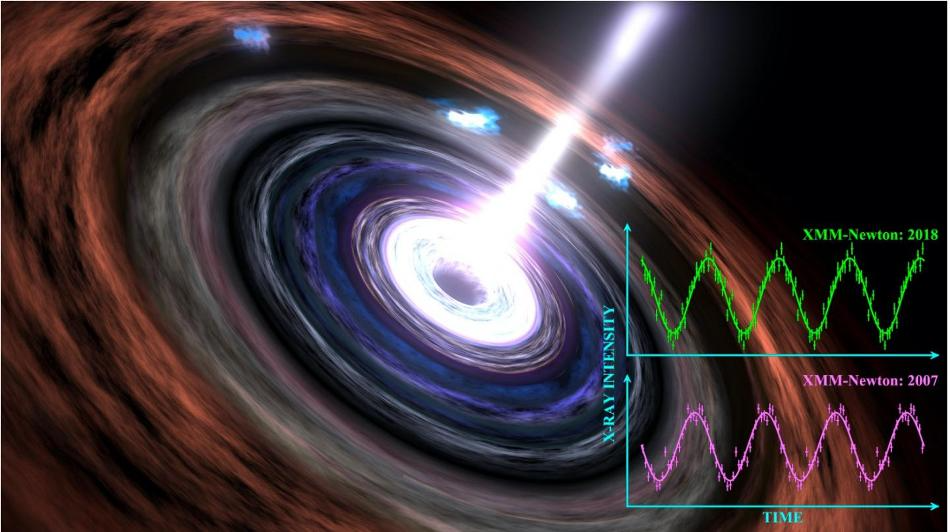Jun 10 2020
A supermassive black hole’s heartbeat, which was the first one to be confirmed, is still ongoing and strong even after a decade of its first observation. The repeated beat was spotted through X-ray satellite observations after its signal was blocked by the Sun for several years.
 A black hole including the heartbeat signal observed in 2007 and 2018. Image Credit: Dr Chichuan Jin, of the National Astronomical Observatories, Chinese Academy of Sciences and NASA/Goddard Space Flight Center Conceptual Image Lab.
A black hole including the heartbeat signal observed in 2007 and 2018. Image Credit: Dr Chichuan Jin, of the National Astronomical Observatories, Chinese Academy of Sciences and NASA/Goddard Space Flight Center Conceptual Image Lab.
According to astronomers, this is the most persistent heartbeat ever observed in a black hole and offers more insight about the structure and size close to its event horizon—the space surrounding a black hole from which nothing, not even light, can escape.
The study by the National Astronomical Observatories, Chinese Academy of Sciences, China, and Durham University, UK, has been reported in the Monthly Notices of the Royal Astronomical Society journal.
In 2007, the heartbeat of this black hole was first detected at the center of a galaxy named RE J1034+396, located about 600 million light-years from Earth. Repeated every hour, the signal from this galactic giant was observed in various images captured before satellite observations were blocked by the Sun in 2011.
The European Space Agency’s XMM-Newton X-ray satellite could eventually re-observe the black hole in 2018, and researchers were amazed to observe the same repeated heartbeat again.
When a supermassive black hole feeds matter that falls on to it from the accretion disk of material that surrounds it, an enormous amount of energy is released from a relatively small region of space. However, this is rarely viewed as a particular repeatable pattern such as a heartbeat.
From the time between beats, the structure and size of the matter in the vicinity of the event horizon of the black hole can be known.
Professor Chris Done, from Durham University’s Centre for Extragalactic Astronomy collaborated on the study with Professor Martin Ward, Temple Chevallier Chair of Astronomy.
The main idea for how this heartbeat is formed is that the inner parts of the accretion disc are expanding and contracting. The only other system we know which seems to do the same thing is a 100,000 times smaller stellar-mass black hole in our Milky Way, fed by a binary companion star, with correspondingly smaller luminosities and timescales.
Chris Done, Professor, Centre for Extragalactic Astronomy, Durham University
Done added, “This shows us that simple scalings with black hole mass work even for the rarest types of behaviour.”
This heartbeat is amazing! It proves that such signals arising from a supermassive black hole can be very strong and persistent. It also provides the best opportunity for scientists to further investigate the nature and origin of this heartbeat signal.
Dr Chichuan Jin, Study Lead Author, National Astronomical Observatories, Chinese Academy of Sciences
The further step in the research would be to carry out a comprehensive study of this interesting signal and compare it with the behavior of stellar-mass black holes in the Milky Way galaxy.
The study was financially supported by the National Natural Science Foundation of China, the Strategic Pioneer Program on Space Science, the Chinese Academy of Sciences, and the Science and Technology Facilities Council, UK.
Journal Reference:
Jin, C., et al. (2020) Reobserving the NLS1 galaxy RE J1034+396 – I. The long-term, recurrent X-ray QPO with a high significance. Monthly Notices of the Royal Astronomical Society. doi.org/10.1093/mnras/staa1356.